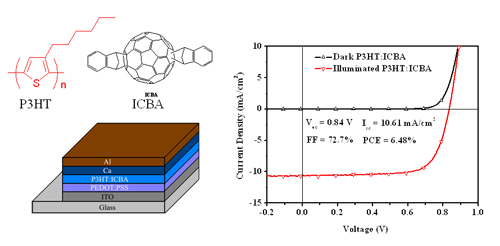Polymer solar cells (PSCs) commonly composed of a blend layer of conjugated polymer donor and soluble fullerene derivative acceptor sandwiched between an ITO transparent positive electrode and a low workfunction metal negative electrode. PSCs attracted broad attentions in recent years because of their advantages of easy fabrication, low cost, light weight and possibility to fabricate flexible devices. Regioregular poly(3-hexyl)thiophene (P3HT) and soluble C60 derivative PCBM are the most representative donor and acceptor materials. Energy conversion efficiency (PCE) of the PSCs based on P3HT/PCBM reached 3.5~4.0% reproducibly, and the P3HT/PCBM blend becomes the standard photoactive layer in the studies of PSCs. But, the HOMO of P3HT is too high or the LUMO of PCBM is too low for the P3HT/PCBM system, which makes the open circuit voltage (Voc) of the P3HT/PCBM-based PSCs is only ca. 0.6 V. The low Voc limited further increase of PCE of the devices.
Under the support of NSFC key project, NSFC-NSF international collaboration project and CMS innovation project of ICCAS, the researchers in CAS Key Laboratory of Organic Solids performed the studies on new fullerene derivative acceptors from last year. They studied the effect of the middle carbon chain length of the substituent of PCBM on the photovoltaic properties by synthesizing a series of PCBM-like C60 derivatives, and found that the PCBM-like C60 derivatives with the middle carbon chain length one carbon shorter or two carbons longer show slightly better photovoltaic performance than PCBM Then, they synthesized indene-C60 bisadduct (ICBA)(molecular structure of ICBA is shown in Figure 1). The LUMO energy level of ICBA is up-shifted by 0.17 eV than PCBM. The PSC based on P3HT as donor and ICBA as acceptor demonstrated a high Voc of 0.84 V and a PCE of 5.44%, under the illumination of AM1.5, 100 mW/cm2. Furthermore, they synthesized the corresponding C70 derivative IC70BA for improving visible absorption of the fullerene derivatives. IC70BA possesses strong absorption in visible region and 0.19 eV up-shifted LUMO energy level than PCBM. PCE of the PSC based on P3HT/IC70BA reached 5.64%.
Recently, they performed further device optimization of the PSCs based on P3HT/ICBA. At the experimental conditions of P3HT/ICBA (1:1 w/w), pre-thermal treatment at 150oC for 10 min, PCE of the device reached 6.48% with Voc = 0.84 V, Jsc = 10.61 mA/cm2, FF = 72.7%. The Voc, FF and PCE are all the highest values reported in literatures for the P3HT-based PSCs. In addition, they collaborated with Chiao Tung University in Taiwan to fabricate inverted PSCs with the P3HT/ICBA as photoactive layer. With the device structure of ITO/ZnO/C-PSBSD/ICBA:P3HT/PEDOT:PSS/Ag, PCE of the inverted PSC reached 6.22% with Voc = 0.84 V, Jsc = 12.4 mA/cm2, FF = 60%. 6.2% is the highest efficiency for the inverted PSCs reported so far.Because of the advantages of simple molecular structure and low cost of P3HT as well as the high stability of the inverted PSCs, this result is of great importance for future application of the PSCs.

Figure 1 Molecular structures of P3HT and ICBA, device structure and J-V curves of the PSCs based on P3HT/ICBA.
